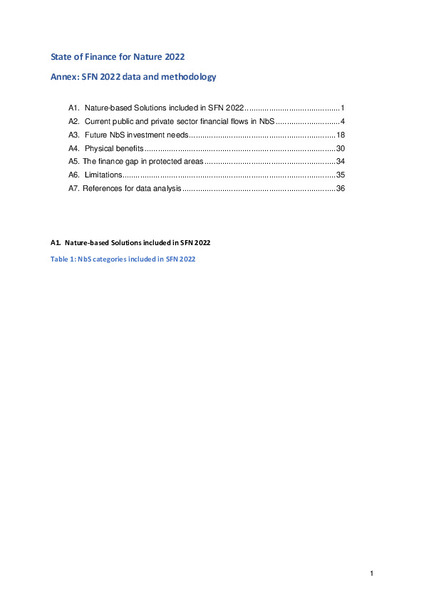| dc.contributor | Ecosystems Division | en_US |
| dc.contributor.author | United Nations Environment Programme | en_US |
| dc.date.accessioned | 2023-03-14T14:48:48Z | |
| dc.date.available | 2023-03-14T14:48:48Z | |
| dc.date.issued | 2022 | |
| dc.identifier.uri | https://wedocs.unep.org/20.500.11822/42067 | |
| dc.description | This second edition of the State of Finance for Nature (SFN) 2022 report i) expands analysis of capital flows to include marine nature-based solutions; ii) estimates the investment in NbS needed to limit climate change to below 1.5°C (in addition to the 2°C target), given the enormous impact this has on nature and people; iii) quantifies public nature-negative capital flows to put into context capital flows to NbS; and iv) estimates the benefits of investing in NbS to demonstrate to politicians, business and finance leaders that nature is a large part of the solution to global crises. | en_US |
| dc.format | pdf | en_US |
| dc.language | English | en_US |
| dc.rights | Public | en_US |
| dc.subject | land use | en_US |
| dc.subject | agroforestry | en_US |
| dc.subject | mangrove | en_US |
| dc.subject | seagrass | en_US |
| dc.subject | finance | en_US |
| dc.subject | nature-based solution | en_US |
| dc.subject | forest | en_US |
| dc.subject | environmental financing | en_US |
| dc.title | Annex: SFN 2022 Data and Methodology - State of Finance for Nature 2022 | en_US |
| wd.identifier.sdg | SDG 15 - Life on Land | en_US |
| wd.identifier.sdg | SDG 17 - Partnerships | en_US |
| dc.relation.TableOfContents | A1. Nature-based Solutions included in SFN 2022 | en_US |
| dc.relation.TableOfContents | A2. Current public and private sector financial flows in NbS | en_US |
| dc.relation.TableOfContents | A3. Future NbS investment needs | en_US |
| dc.relation.TableOfContents | A4. Physical benefits | en_US |
| dc.relation.TableOfContents | A5. The finance gap in protected areas | en_US |
| dc.relation.TableOfContents | A6. Limitations | en_US |


